If you’ve been in the climbing or canyoning scene for a few years, you’ve probably tried a slew of different rappel and belay devices. The most modern devices, such as a Grigri or REVO offer assisted braking to try and correct in case of belayer inattention or error. Every belay device has its drawbacks however, and most outdoors enthusiasts own several different types for different conditions and activities.
scene for a few years, you’ve probably tried a slew of different rappel and belay devices. The most modern devices, such as a Grigri or REVO offer assisted braking to try and correct in case of belayer inattention or error. Every belay device has its drawbacks however, and most outdoors enthusiasts own several different types for different conditions and activities.
The Figure 8, also known as an 8 ring, is one of the simplest rappel devices, and has been around for a long time. The earliest versions were used in the 60’s, though the inventor is unknown. In recent years, Figure 8’s have largely disappeared in climbing areas, due to the popularity of the ATC ( how to rappel with an ATC
how to rappel with an ATC )
) , as well as the publicity of a few fatal accidents (more information below).
, as well as the publicity of a few fatal accidents (more information below).
I used to use a Figure 8 primarily for canyoneering, because I liked it better than an ATC in certain situations. Because of the risks involved with Figure 8 devices, it’s very important to set up the rappel correctly and know the dangers involved.
If you’re still using an 8 ring for rappelling though, you’re missing out on the latest developments in safety and convenience that come from canyoneering-specific devices like the Hoodoo and Critr. You can read about them in this article I wrote .
.

How to Rappel with a Figure 8 Device:
- Set the rope through the anchors, and check that anchors and harness are secure, with the carabiner clipped through the load-bearing loops of the harness (not the belay loop). The carabiner gate should face upwards.
- Stand with the rope on your right side, and pinch a section of it and tuck it through the larger ring of the Figure 8 from the bottom. Pull the loop through, and go around the ‘neck,’ or bottom of the 8 ring. If rappelling both strands, thread both strands through the big hole and around the neck.
- Clip the smaller hole of the Figure 8 through the carabiner, and lock the carabiner.
- Check everything again, making sure the carabiner is locked through the bottom hole, and that the rope(s) comes from the anchor through the top (bigger) hole, around the neck, and out the top hole again.
- Adjust the Figure 8 device so that it doesn’t rest on the gate of the carabiner at all. This is a failure mode.
- Grab the right (downhill) side of the rope in your right hand (brake hand) and pull it behind your back to stop. Your left hand can rest on the rope above the Figure 8 if you want.
- Lean back into the rappel, and accelerate by sliding your brake hand out away from your body. Pull the rope behind your body to stop. For more information on general rappelling techniques, ready this article
 .
.
See Also: Tips for Safer Rappelling
Pros of a Figure 8 Device:
Simplicity
Figure 8 rappel devices are very simple to set up, and there is little room for error. The rope just has to come through the top of the 8 and around the neck. Figure 8’s can’t get locked up like most tubular devices like an ATC, because the rope continuously flows around the neck of the device without jumping down to the carabiner and back.
Additionally, Figure 8’s provide a very smooth rappel, and aren’t as jerky as other rappel devices. The ease of use, especially the set up, makes them somewhat popular among mountaineers (read: Rock Climbing vs. Mountaineering) and ice climbers who can’t remove their gloves to fumble with a rope in freezing temperatures.
and ice climbers who can’t remove their gloves to fumble with a rope in freezing temperatures.
Heat Dissipation
Figure 8 devices dissipate heat better than ATC’s because of the additional surface area. You’re less likely to end up with the imprint of an 8 burned into your hand after a long rappel than an ATC- they still heat up much more than a rappel rack however.
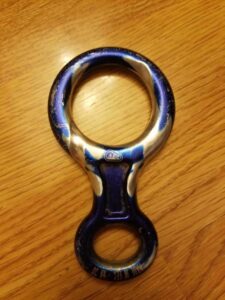
Price
Figure 8’s have a very low price point, usually between $10-15, and they usually last a long time. It’s really easy to adjust the friction and speed of the rappel, so people of all different sizes, and carrying different loads can use it (more info & direction below). The other price advantage is that the rope only wraps around and wears out the Figure Eight. When using an ATC, the rope runs through both the tuber and the carabiner, slowly wearing through both metals. Some sand- and mud-intensive canyons can almost wear through a whole 8 ring in one day, so it’s nice to have a cheap 8 for such cases.
Friction
A Figure 8 has less friction than an ATC, making it easier for a small person or child to descend. With a Figure 8 you can make a couple of modifications to the set up and significantly influence the speed of the rappel- slowing it down or speeding it up as needed (more info & direction below).
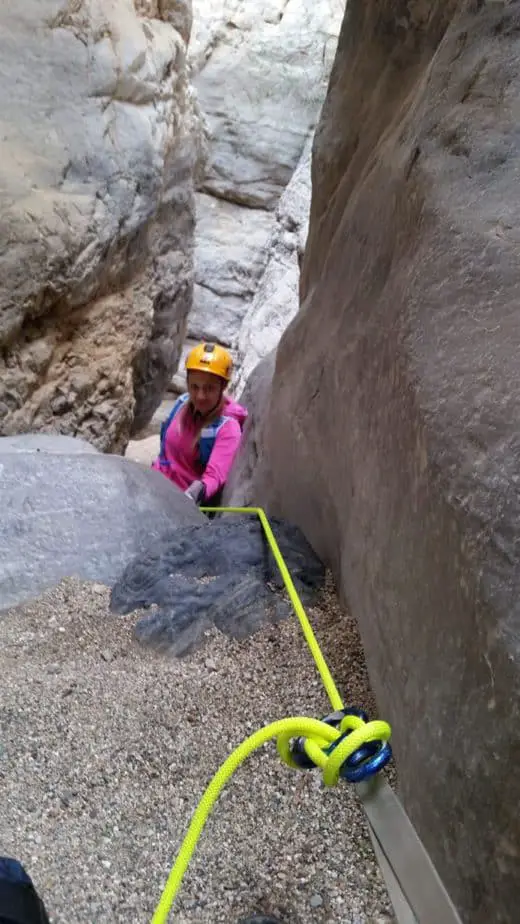
Versatility
A Figure 8 is extremely versatile. Rappelling with a narrow half rope? Both strands of an 11mm rope? It doesn’t matter. Pretty much any combination of ropes will fit through a Figure 8. Continuing along with the idea of versatility, a Figure 8 can even be used to belay- though it shouldn’t be setup the same way as the rappel setup (more on Figure 8 belaying later in the article). A common use for an extra 8 ring canyoneering is to lock off one side of the rope to the anchor by tying the 8 into an 8 block (more info & direction below). This makes a retrievable rappel possible without having to double up the rope.
See Also: How to Rappel Without Leaving Gear
Passability
With a Figure 8, it is very unlikely that mud or moss will freeze you up when canyoneering, as is known to happen with tubular belay devices sometimes. The large opening in the 8 ring, as well as the smooth flow of the rappel and decreased friction allow mucky ropes and even small knots to pass through without presenting a problem.
Quick Release
In swift water canyons, or when rappelling into deep water, a figure 8 device rappel can be rigged so that there is no risk of dropping hardware into the water. This way you don’t get stuck without a rappel device in the middle of the canyon, and don’t get stuck on the rope while descending. More information on the Figure 8 “Canyon Mode” Quick Release setup later in the article.
Cons of a Figure 8 Device
Danger
Figure 8’s have been around for a long time, and there have been a few accidents- fatal and otherwise. A few different fatalities have occurred due to something called cross loading. This can happen when the force of the 8 ring breaks through the sleeve of the locking carabiner. The force is applied to the pins, and can make them pop out.
When the smaller hole of the 8 is clipped through the carabiner, occasionally the bends in the carabiner or the locking sleeve itself get caught in the 8. As pressure is applied, it turns the 8 ring into a lever and the force can pop the gate open (outwards is called cross loading, while inwards is called inward loading). A locking carabiner is generally designed to stand a force of up to 45kN; however, the gate holds roughly a third of that.
When the Figure Eight becomes a lever it amplifies the cross gate force and can bust the biner. Again, this is very rare; however, it has happened a few times. It can be avoided by adjusting the carabiner in the 8 ring as you load the system, and ensuring the carabiner and 8 are not jammed near the gate.
Climbing Belay
Just because a Figure Eight can be used as a belay for climbing doesn’t mean it should be. Nowadays, there are simply better devices out there that are specifically designed for the rigors of climbing! Get yourself an ATC or a Grigri. If you do forget your regular belay device, feel free to use an 8 ring- just know how to set it up correctly. It’s safe, and altogether not too inconvenient. You need to use a chord or sling to keep the 8 from flying up the rope. More information and details about how to belay with an 8 ring below-
Lower Friction
A Figure 8 device puts less friction on the rope than a regular ATC, or other devices- whether good or bad. This means you’ll go faster, but also have less control. This is important to keep in mind when rappelling with beginners. Figure 8’s were a lot more useful when climbing and rappelling ropes were thicker. Older ropes won’t even fit through an ATC (I learned a little while back mid-canyon). Modern ropes are made of stronger, thinner material, which creates less friction on the 8 ring and makes you zip down the rappel. There are a few ways to modify the traditional Figure 8 rappel to add more friction, which we’ll discuss below.
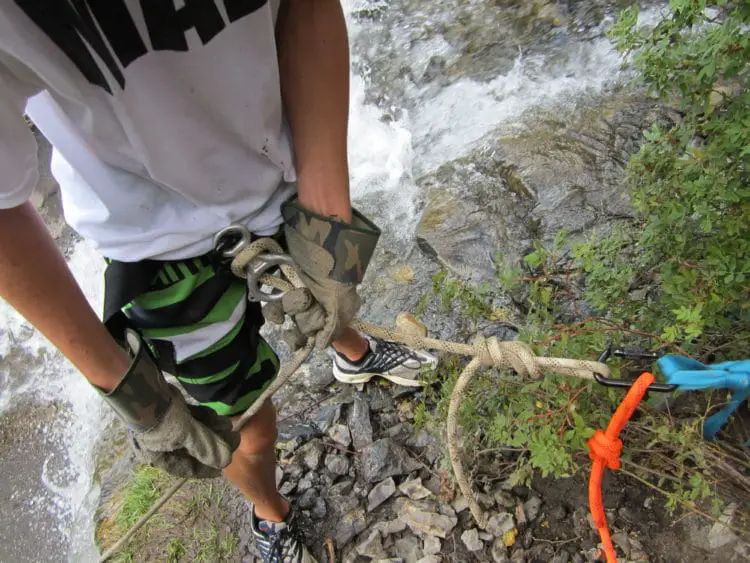
Rope Twist
One downside of rappelling with a Figure 8 is that it introduces a lot of twist into the system. This won’t cause any damage to the core of the rope , but it can unintentionally tie knots down the line and make a mess of your kit. This can be avoided by rigging the rappel sport style (instructions down below).
, but it can unintentionally tie knots down the line and make a mess of your kit. This can be avoided by rigging the rappel sport style (instructions down below).
Perception
Figure 8’s have a bad reputation right now in the climbing community. They are looked at as ‘old-fashioned,’ and are frowned upon. I’ve had multiple people come up to me in crags or in canyons and tell me that they used to use 8 rings, and that there are better devices to use now. I mostly ignore them, because I like using a Figure 8 for certain things because if its features, as discussed above. That being said, if you really care what other people think, buy something flashier. A Figure 8 is a great conversation starter, and a good way to make friends with some of the older crowd at the crag!
See Also: What is the Best Rappel Device for Canyoneering?
Different Kinds of Figure 8 Rappel Setups
As mentioned above, one of the biggest advantages to rappelling with a Figure 8 device is its versatility. With a little modification, you can increase or decrease friction, stop completely, and even disconnect from the rope without unlocking the carabiner! These variations will be very beneficial when rappelling with people of different sizes, and when rappelling in different conditions. Unfortunately, there’s really no good way to change the friction level with a standard 8 ring once you’ve loaded the system. Whenever possible, tie in and test out the system before stepping over the ledge, just in case you need to adjust the friction.
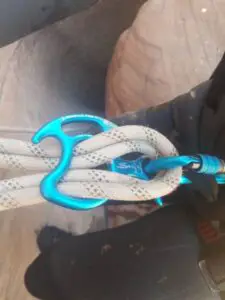
Different Kinds of Figure 8 Devices
Eight rings come in several different sizes, and with a few different features. Small Figure eights create more friction. Large ones have less friction and are a lot faster. Rescue 8’s have ‘ears,’ ‘wings,’ or ‘horns’ on the top of the large loop, and have an additional hole in the middle. These can be used to easily lock off and tie off a rappel. The biggest advantage to a Rescue 8 is that you can adjust the friction level mid-rappel by adding an extra wrap around the horns.
A couple of companies have created variations of the Figure 8 device with different features. A few examples include the Kong Oka, and the Petzl Pirana. They perform largely the same job, but also include extra features designed for specific tasks (when carrying the Kong Oka, I always worry I’ll accidentally end up with an appendectomy!).
Figure 8 Device Regular Rappel
We went into detail about the setup for the regular rappel at the beginning of this article. The rope loops around the neck of the 8 ring. This is the standard level of friction, with no variations. To avoid the serious risk of cross loading the carabiner, make sure the 8 ring isn’t stuck around the gate when you weight the system, and maintain a constant load on the system.
Figure 8 Device “Sport Mode” Decreased Friction
The “sport” setup is often used for kids and smaller people so they can smoothly rappel without having to jerk on the rope. This setup also helps when ropes are wet and/or gritty. Rigging this way significantly decreases the amount of friction, and actually eliminates the rope twisting problem mentioned above. The only difference between this and a regular rappel is that instead of looping the rope around the neck of the 8 ring, you just come through the big hole and clip it down into the carabiner. Don’t forget to lock the biner.
Figure 8 Device “Rescue Mode” Increased Friction
In some instances, you may want to actually increase the friction on the 8 ring. This may be the case if you are trying to add more control into the system, such as when performing rescue work. You can also use this set up for heavier people who may need more friction to keep from zipping down the line out of control.
To rig a rappel with extra friction, pinch a bight of rope through the large hole of the 8, and then loop around and thread it through the large hole a second time (can repeat a third time if needed) and then around the neck. Multiple loops will heat up the device a lot quicker, but will really increase the friction for heavier loads.
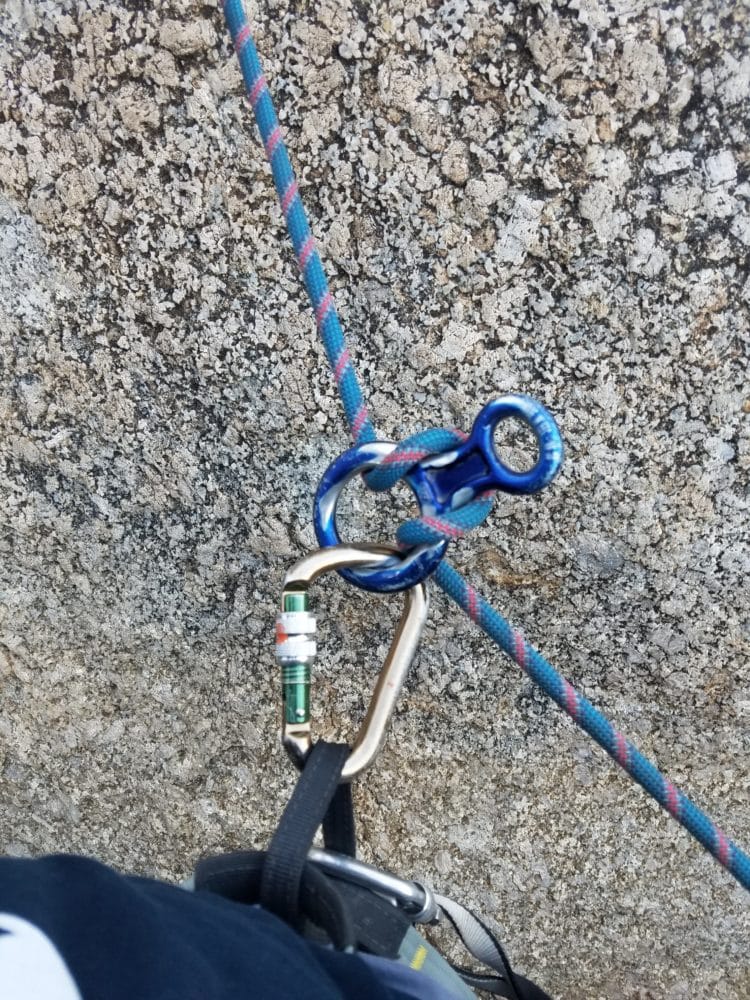
Figure 8 Device “Canyon Mode” Quick Release
One very important use when canyoning and caving into swift water (class C canyons ) is to present a quick release from the rope without the added risk of drowning while stuck on the rope or of dropping hardware in the water. When you are wearing gloves and are shivering from the cold water and adrenaline, it can be very easy to fumble with your Figure 8 device or carabiner and lose it forever to the canyon gods.
) is to present a quick release from the rope without the added risk of drowning while stuck on the rope or of dropping hardware in the water. When you are wearing gloves and are shivering from the cold water and adrenaline, it can be very easy to fumble with your Figure 8 device or carabiner and lose it forever to the canyon gods.
While using an ATC during a waterfall rappel into a swimmer this past summer, I accidentally dropped my ATC while treading water and trying to disconnect. I made a mental note of my exact location, and then handed my backpack and shoes off to another member of the party. I spent several minutes diving down and feeling around with my toes for the device. I did have a backup, but it’s never fun to lose gear in a canyon. Fortunately, I ended up finding it about 15 feet down, wedged in between some rocks in the mud on the bottom. Next time I’ll just use the quick release set up on my Figure 8!
during a waterfall rappel into a swimmer this past summer, I accidentally dropped my ATC while treading water and trying to disconnect. I made a mental note of my exact location, and then handed my backpack and shoes off to another member of the party. I spent several minutes diving down and feeling around with my toes for the device. I did have a backup, but it’s never fun to lose gear in a canyon. Fortunately, I ended up finding it about 15 feet down, wedged in between some rocks in the mud on the bottom. Next time I’ll just use the quick release set up on my Figure 8!
- Clip the large hole of the 8 ring into the carabiner, and orient it so the small hole is on the right (if right-handed).
- Pinch a bight of rope through the large hole from the bottom and wrap it around the neck of the Figure 8 device.
- Rappel normally, though cautiously. Do NOT unweight the system, as the rope could come off.
- Once stable on the ground (in the water), simply pull the rope around the neck of the device and let go to disconnect
How to Lock off a Figure 8 When Rappelling
A Figure 8 device can easily be locked off while rappelling by moving the rope in your brake hand across your body so it crosses the uphill rope. Cinch it down tightly in between the 8 ring and the rope, and keep the system loaded. Nothing is tied, but the friction is such that it will hold you as long as you don’t bounce or unload and reload the system. This can be very helpful if you need to untangle the rope below you, or stop for any reason, and this is a capability a regular ATC doesn’t have. Rescue 8’s make this even easier with horns.

How to Set up an 8 Block for Canyoneering
One of the best uses for an 8 ring when rappelling, especially when canyoneering, is as an 8 block in a retrievable rappel. An 8 block is used to create a ‘stop’ in the rope on one side of the anchor that can’t pass through a quick link so you can rappel down a single strand of rope. Then, once on the ground, you can pull the other strand of rope (the side with the 8 block) and pull the rope.
You should use an 8 block and rappel one strand of the rope whenever possible so that in case there’s an emergency with the person on rappel, you can go down the other side of the rope to assist. It also makes it easier for rappels that don’t require the full length of your rope because you pull out exactly what you need and leave the rest in the bag. You can tie a large knot in the rope instead of using an Eight, but the stress in the system will make the knot extremely difficult to untie. An 8 block is an important skill to master, and needs to be set up correctly every time. Always double check that you are tied into the side of the anchor without the 8 block- a mistake here will be catastrophic.
- Pinch a bight of rope through the large hole of the 8 ring, and loop it around the neck of the device as if you were rappelling.
- Take either side of the rope and pinch a bight back through the large hole from the opposite side, looping it around the neck.
- Tug on the rope until the 8 block is snugly against the quick link in the anchor.
- Tie into the rope on the opposite side of the anchor as the 8 block, and rappel.
- Disconnect from the rope, and then pull the other strand of rope down, taking care that the 8 ring doesn’t get caught on anything and doesn’t hit your head as it falls.
See Also: How to Rappel Without Leaving Gear
Can you Belay Rock Climbers with a Figure 8?
Well, it’s been done for a long time! Some of the earliest belay devices, like the Sticht Plate, were incredibly simple. Even with the rudimentary design and function, they got the job done! Over the years, they’ve simply added a few features to solve the main problems with each device, solving problems and making belaying smoother and safer. For example, an ATC is basically a Sticht Plate that is 3 or 4 times the ‘height’ (to reduce the frequency of the system locking up), and with an added wire keeper loop (so the device doesn’t shoot up the rope and so you can carry it easier).
A Figure 8 device works just like a traditional Sticht Plate, using the small hole in the biner as the slot. Do NOT set up the Figure 8 the same way that you rig it to rappel; this is largely unsafe because of the lack of friction, as well as the danger of cross loading detailed above. Using the small hole in the 8 ring adds a significant amount of friction, but still allows for very soft catches. This can be nice for top roping, but for lead climbing you usually want more stopping power.Belaying with a Figure 8 can be completely safe, as long as it is rigged correctly.

- Pinch a bight of rope through the small hole in the Figure 8 with the large hole on the left (if right-handed). The ‘live’ end of the rope with the climber attached should come out the left side of the hole, while the ‘brake’ side should come to the right.
- Clip the carabiner (in the belay loop) through the newly created loop of rope and lock it.
- Tie a piece of chord or use a quick draw to connect the large loop of the 8 ring to your harness to prevent it from shooting up the rope when the system is slack (like a wire keeper loop on an ATC).
- Belay normally with your brake hand on the right side of the rope.
Figure 8 vs. ATC
Most of this has been discussed in detail above; however, I wanted to touch on the key differences between the two devices to help you select which is better for you. A Figure 8 is universal, meaning it will fit any diameter of rope, it can be used for rappelling and climbing, and you can easily adjust the speed/friction levels. Tubers can be used for both climbing and rappelling, but they are single speed and usually won’t work with ropes thicker than 11mm. They are smoother and generally safer than Figure 8 devices for climbing because of the inherently higher friction levels and limited risk of cross loading.
There is no single ‘best belay device,’ and I think it is best to have a few different ones on hand for when you may need them. A Figure 8 device is a classic piece of hardware that has stood the test of time, and has a defined role in all climbing sports . No matter what you use, use it as directed by the manufacturer, be safe, and have fun. Good luck out there!
. No matter what you use, use it as directed by the manufacturer, be safe, and have fun. Good luck out there!
See Also:
Can you Rappel with a Belay Device?
